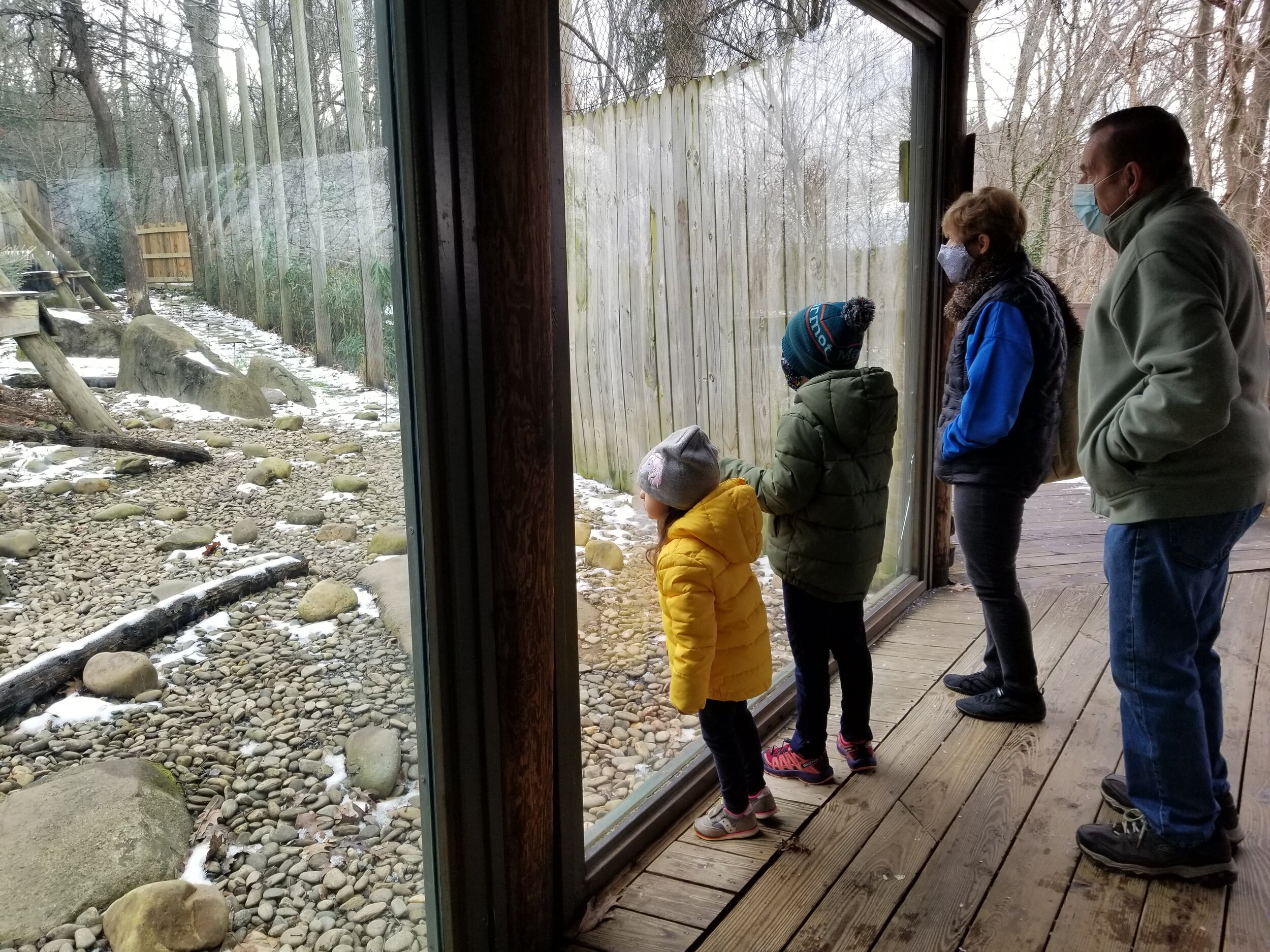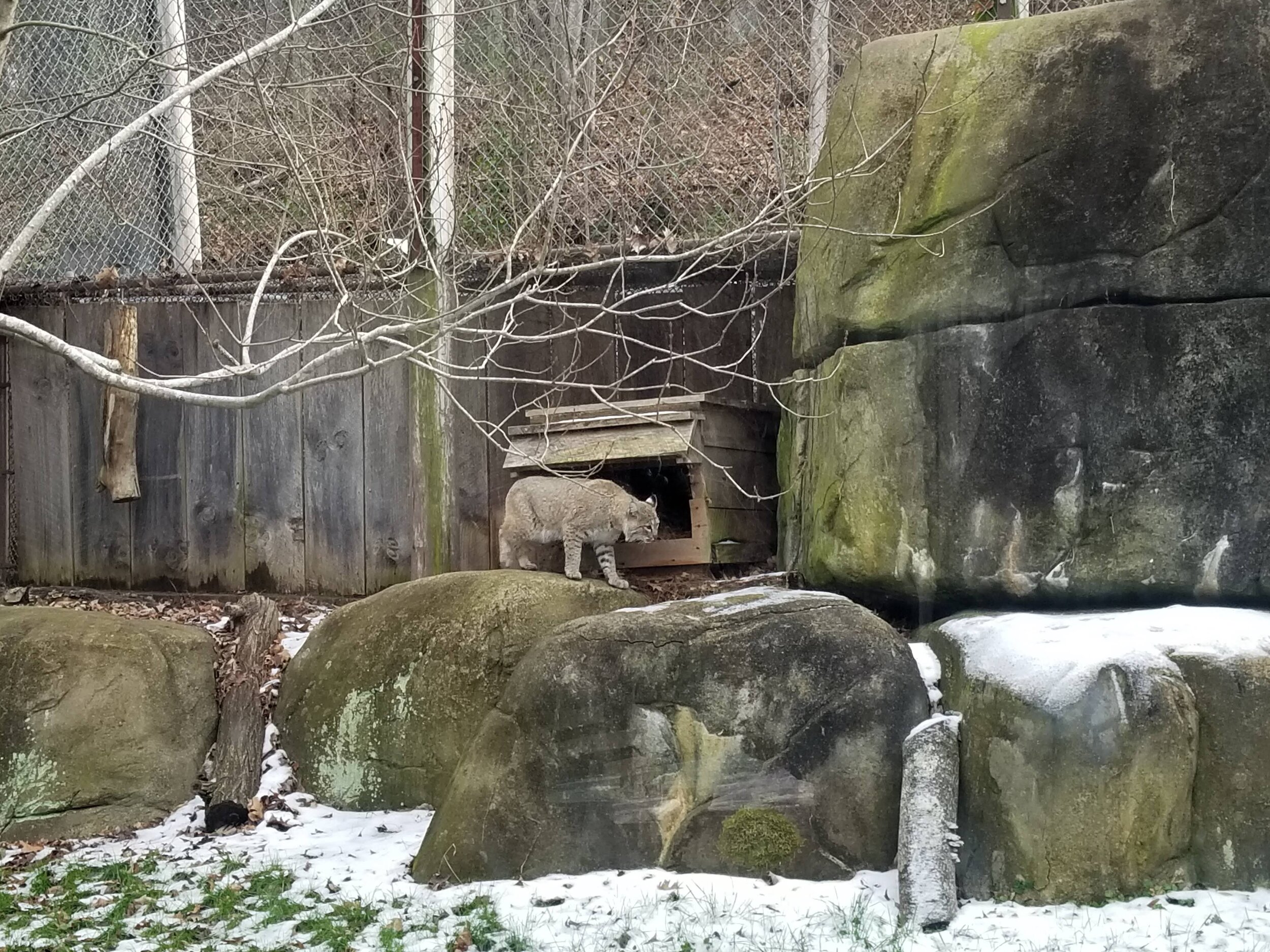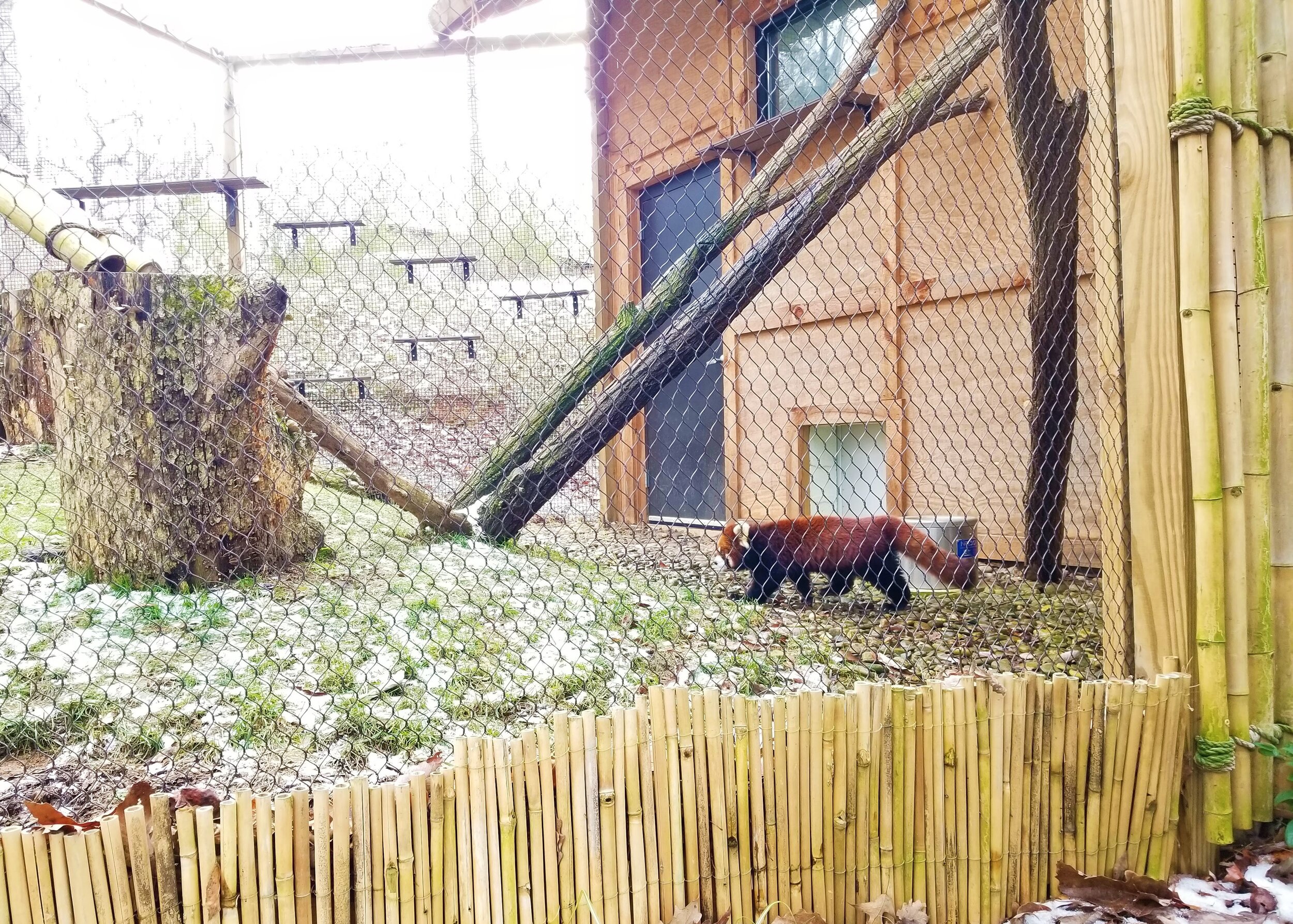WNC Nature Center in Asheville, NC
Keeping Appalachia Wild
Visitors view a habitat at WNC Nature Center in Asheville, NC. Photo by Carrie Dow.
The beauty of the Appalachian Mountains in western North Carolina is without question. Outdoor enthusiasts and nature lovers have been drawn to this area, home to Great Smoky Mountains Nation Park and the Blue Ridge Parkway, for centuries. However, what visitors may not always encounter when out in nature are the multitude of animals that once called these mountains home. That’s because we humans have hunted the animals, cut down the forests, and dammed the rivers altering the terrain these animals once roamed.
To remind us of what these mountains once looked like, the Western North Carolina Nature Center (WNC Nature Center) in Asheville opened in 1976 with a triple mission: To save the wildlife who call this part of North Carolina home, teach people about Appalachian flora and fauna, and to preserve what habitat remains. While a monumental task, when you see these animals up close and hear their story, you realize we need more places like this.
Located southwest of downtown Asheville, WNC Nature Center sits on a 72-acre hillside with the Swannanoa River running along the park’s lower boundary. The center is owned and operated by the City of Asheville as part of the Parks and Recreation Department, however, a non-profit organization, Friends of the Nature Center, is the main fundraising and support arm providing needed funds and volunteers to take care of the animals and refurbish the habitats.
Scruffy, a great horned owl, looks on from a perch in the Birds of Prey habitat. Photo by Carrie Dow.
The WNC Nature Center originally opened in the 1930s as the Asheville City Zoo, a typical entertainment zoo of the era when exotic animal ownership took hold in the US. Like many zoos back then, exotic animals were taken from their natural habitats and housed in crowded, unnatural conditions for people to ogle. Due to financial hardship, it closed around 1970. Realizing the need for more humane conditions and locally focused conservation, some conscientious citizens with help from the zoological community reopened the facility as the WNC Nature Center in 1976.
Volunteer and Community Outreach Coordinator Candace Poolton showed me around on a chilly, but sunny December day. She proudly tells me the center is an accredited member of the Association of Zoos and Aquariums, a national organization that provides accreditation through a rigorous process to ensure that animals are protected and not exploited.
“We’re unique in that we don’t have any elephants or giraffes,” informs Poolton. “These animals are native to the area, so they are used to the climate and it’s easier to keep them happy and healthy.”
The nature center is divided into various large and small, indoor and outdoor habitats and all the animals in the center came from rescue situations or were found injured. Since these animals have special needs, they can no longer survive in the wild and instead live in the security of the nature center while teaching us more about about them.
When you enter the center, you pass the newly updated front entrance with a small courtyard and a giant barn where the center’s agricultural animals are housed. Domesticated animals like goats, sheep, and chickens became a part of Appalachia when Europeans moved into the area bringing these animals with them. In the outdoor pens guests will encounter Cotswold sheep, Angora goats, and Nigerian dwarf goats. Most of these animals were given up by local owners after being unable to care for them anymore.
“We have a mix of heritage breeds, breeds that are considered rare now-a-days, but were the foundation of southern Appalachian farming,” says Poolton.
The nature center is amid a decade-long restructuring project where they are updating all the animals’ habitats and that will continue to 2025. Projects already completed are the aforementioned entrance and barn, a new children’s playground, and enhancements to the red wolf habitat. One of the things they are currently working on is the bear habitat and viewing walkway.
“Uno and Ursa (the bears) were sized by the North Carolina Wildlife Resource Commission from another facility that wasn’t taking care of them properly,” Poolton tells me. “They lived in what’s called bear pits. Giant cement enclosures. They had never seen grass before. Now they have plenty of grass!” Uno and Ursa will spend most of the winter in their den. Poolton says they come out to stretch occasionally, but aren’t as visible as they are in the summer. Before they go into hibernation, the center helps fatten them up with all the acorns they can eat besides their regular diet of fresh fruits and vegetables and something called an omnivore biscuit. She says Asheville residents often collect buckets of acorns in the fall that they bring to the shelter for the bears to enjoy.
Behind us is the Birds of Prey habitat. All the birds in the center were found injured.
“All the birds of prey here are victims of car accidents,” explains Poolton. “The takeaway message is to not throw garbage out of your window while you are driving. Even compostable materials. It attracts birds to the side of the road. That’s how all these guys got hit.” The center is home to two barred owls, Scruffy the great horned owl, three red tail hawks, and a turkey vulture named Buzz. Since all have damaged wings and two are missing an eye, Poolton says their habitats are specially designed to keep them safe.
“They can’t fly,” she states. “You’ll notice the branches are all closer together and low the ground to prevent injury in case they were to lose their balance and fall.”
Poolton points out the white tail deer habitat beyond the bear habitat. The center currently has two deer, Curly and Becca. While I didn’t see Curly through the brush, Poolton said he was there (she spots the animals effortlessly) and Becca followed us along the fence for a bit before losing interest. Both were once kept as illegal pets. They’re also popular with visitors.
“It’s funny, you think oh, it’s just a deer,” Poolton shrugs, “but there are people that travel from all over the world that have never seen a white-tailed deer before. People that live in cities that have never seen a deer up close.”
Missy the bobcat. Photo by Carrie Dow.
While pondering that, Poolton enthusiastically says, “Let’s check out some big cats!” and we turn up the hill. First up is Missy the bobcat making her way down the trunk of a hemlock tree. At first I don’t see her, but I can see the branches waving as she makes her way down. Once on the ground I’m stunned to see she isn’t much taller than a house cat as she saunters over to a covered shelter to sit in the shade.
“I believe she’s 18 [years old],” Poolton mentions. She also adds that Missy and all the animals in the center get some type of stimulating enrichment throughout the day. For the large animals, staff will rearrange furniture, provide a new treat or toy, or introduce a new scent.
Mitchell the mountain lion. Photo by Carrie Dow.
“Imagine if you were stuck in the same room all your life. You’d want things to keep it interesting,” illuminates Poolton. “My favorite enrichment for Missy is to give her a box with pine straw with another box inside with more pine straw and some catnip. We recently had a local Christmas tree farm donate some trees for the animals. Our wolves in particular really enjoyed that.”
“We also do something called target training,” Poolton continues. “We teach animals like Missy to move in certain ways so the vet can observe. Most of our animals offer themselves for injections. Instead of having to catch and hold them down, which is super stressful, they get rewarded to participate in their own health care.”
Next to Missy is Mitchell the mountain lion. Poolton says he and his brother came to the Nature Center about ten years ago. They were found orphaned in the wild by a hiker.
Visitors observe a grey wolf at WNC Nature Center. Photo by Carrie Dow.
“The hiker did the right thing and left them alone in case mom was still around,” Poolton says. “He came back the next day and saw they were emaciated and no mom to be seen. What we think happened is that mom was poisoned. Before she died, she passed the poison in her milk to her babies because when we got them, they both had stage two kidney failure. We did lose his brother two years ago, but we’ve got [Mitchell’s] under control. Right now he is healthy and comfortable.”
Up next are the center’s gray wolves, Nova and Wayah, who arrived at the center from a facility in Montana.
“They’re brother and sister,” Poolton tells me. “They come from a wolf rescue and weigh about 80 pounds.”
As we walk, Poolton says they have two habitats for the center’s red wolves. Red wolves are critically endangered and the center is part of a species survival program through the AZA and works to not only breed the wolves, but to keep them away from human contact so they can be reintroduced into the wild. Red wolves are a bit smaller than their grey wolf counterparts and only found in the wild in a small section of eastern North Carolina. Wolves Garnet and Karma are relatively new to the Center and it is hoped they can have a litter of pups that will provide more diversity to the species and, maybe someday, be released into the wild.
The barn at WNC Nature Center in Asheville, NC. Photo by Carrie Dow.
“We’ve had 13 red wolves born here, which is impressive,” says Poolton. “Red wolves are technically extinct. There’s only 20 left in the wild and only 250 left in the world and you’re looking at two of them.”
We then walk by the center’s newest habitat opened in 2018, red panda. I mention it seems odd to have Asian red pandas in a North American zoo. Poolton explains that red pandas have a surprising connection to Appalachia.
“[Red pandas] were once part of prehistoric Appalachia,” enlightens Poolton. “There were red pandas here millions of years ago. This environment suits them very well.” Turns out that Asheville’s climate and altitude matches that of their central Asian home. Red pandas are also fascinating creatures. They are arboreal animals meaning they live in trees and have what’s called a “false thumb,” which is a modified wrist bone that they use to grasp bamboo, their main food source. Leafa the female is curled up like a cat on a ledge at the top of a climbing pole inside the habitat while Phoenix the male walks around the grass before casually walking up a tree trunk placed on its side inside the enclosure. His rust-red fur shines in the sunlight and I can see brownish rings around his tail.
Display showing finished and upcoming WNC Nature Center projects. Photo by Carrie Dow.
“Bamboo grows here unnaturally; it’s an invasive species,” adds Poolton. “We have people all the time who bring in bamboo from their yards.” The center also has a patch of bamboo that they grow and harvest onsite for the red pandas. The red panda habitat brings more animal diversity to the center, which we visitors get to enjoy and learn about while the center helps to preserve their population. It’s a unique relationship.
We make our way to another of the center’s larger habitats, the North American river otter. Opened in 2010, Brandon’s Otter Falls is a stream, waterfall, and otter habitat that was named after a young boy who had passed away from cancer. Poolton tells me his parents brought him to the center all the time and the otter habitat was his favorite. In his honor, his parents donated money to update the habitat. A tranquil stream flows from the top of the walkway down through a meadow with a tunnel for the otters to the main pool below. Poolton says in the summer the otters like to sun themselves on the rocks and that their diet consists mostly of restaurant-quality trout supplied by a local farm.
“If you eat trout at an Asheville restaurant, it’s probably the same trout that they’re eating,” she states. Watching the otters, Olive and Obi Wan, dive and swim eagerly in the pool is one of the highlights of my visit.
Poolton points out the center has an indoor reptile habitat called Appalachian Station. It is home to one of the largest salamanders in the world, a two-pound Hellbender named Meatloaf. Poolton notes that salamanders are important indicator species for Appalachian biology. The animals’ natural habitat is in and around rivers and streams and they are extremely sensitive to toxins. A North Carolina water way without salamanders means the water is polluted.
Appalachian Station is also home to several snakes and reptiles including copperhead and timber (both poisonous), corn snakes, rough green, and black rat (‘It’s a great place to practice your snake identification,” chuckles Poolton) along with tree frogs, toads, and endangered box turtles. Unfortunately, Appalachian Station is closed because of pandemic precautions. With warm weather and vaccines coming in the spring, hopefully the center will be able to open fully and operate the many summer programs they offer for kids and adults, including summer camp for elementary students.
Poolton says the next big project for the WNC Nature Center is a butterfly garden featuring heritage wildflowers and monarch butterflies. They have already received a generous private donation to start the project and continued fundraising is underway. I’ll be sure to enjoy that on my next visit.
***
To view these and many more animals such as raccoons, foxes, chickens, turtles, and even insects, visit WNC Nature Center at 75 Gashes Creek Road in Asheville, NC. 828-259-8080
Additional Info & COVID-19 Precautions
Due to COVID-19, the nature center requires all guests to wear masks and not to congregate in large groups. If you see a group of people in a particular viewing area, Poolton suggest visiting another, less crowded habitat and then return when it’s not as full. The center has also closed all indoor habitats, including the petting barn, Appalachian Station, and the Wild Winds simulator. The gift shop has been moved to the open air of the barn. Guests are also encouraged to purchase tickets online for contactless entry. For a full list of regulations and precautions, visit the website.
The WNC Nature Center is currently open from 10 am to 4:30 pm daily with last visitors to enter at 3:30. The center does close during inclement weather so check the website or Facebook page. Fees are $10.95 for adults, $9.95 for seniors (65 and older) and $6.95 for kids up to 15. Children 2 and under are free. There are additional discounts for Asheville residents.
Phoenix the red panda explores his habitat at WNC Nature Center. Photo by Carrie Dow.















